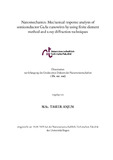Citation link:
http://dx.doi.org/10.25819/ubsi/9903Files in This Item:
| File | Description | Size | Format | |
|---|---|---|---|---|
| Dissertation_Taseer_Anjum.pdf | 27.54 MB | Adobe PDF |  View/Open |
| Dokument Type: | Doctoral Thesis | metadata.dc.title: | Nanomechanics: Mechanical response analysis of semiconductor GaAs nanowires by using finite element method and x-ray diffraction techniques | Other Titles: | Nanomechanik: Mechanische Response-Analyse von Halbleiter-GaAs-Nanodrähten mit der Finite-Elemente-Methode und Röntgendiffraktionstechnik | Authors: | Anjum, Taseer | Institute: | Department Physik | Free keywords: | Semiconductor nanowires, Manomechanical properties, X-ray diffraction, Gorsky effect, Three point bending test, Finite element method | Dewey Decimal Classification: | 530 Physik | GHBS-Clases: | UIQO UIOS UIUD |
Issue Date: | 2021 | Publish Date: | 2021 | Abstract: | In den letzten zwei Jahrzehnten wurden durch die Integration von quasi eindimensionalen Nanodrähten enorme Fortschritte bei der Miniaturisierung von opto-elektronischen Bauelementen und sensorbasierten nano-elektromechanischen Systemen erzielt. Für die Entwicklung von Nanodraht basierten Bauelementen der nächsten Generation ist es unerlässlich, die zugrundeliegenden Deformationsmechanismen und deren Mechanik zu untersuchen. Die vorliegende Arbeit demonstriert die Analyse des mechanischen Verhaltens von Halbleiter Nanodrähten aus Galliumarsenid (GaAs), die mittels Molekularstrahlepitaxie auf Siliziumsubstrat gewachsen sind. Das mechanische Verhalten der Nanodrähte wurde durch in-situ Biegeversuche im Rasterelektronenmikroskop und in Kombination mit Röntgenbeugung untersucht. Infolge der rassanten Entwicklung von Röntgenfokussieroptiken stehen inzwischen an verschiedenen Synchrotronanlagen nanometergroße Röntgenstrahlen zur Verfügung, die es ermöglichen, einen einzelnen Nanodraht zu untersuchen. Das erste Ziel dieses Manuskripts war es, die Auswirkung einer systematischen dynamischen Belastung, d.h. elektromechanisch induzierter Vibrationen, auf einzelne Nanodrähte mit Hilfe der Bragg Beugungsabbildung zu untersuchen. Die parametrische Studie wurde entweder durch die Variation der Amplitude der Resonanz oder der Verweilzeit durchgeführt. Das ex-situ-Experiment, das die kristalline Struktur und die Phasen dieser vibrierenden NWs untersuchen sollte, war für März 2020 geplant, aber aufgrund der Ausbreitung der COVID-19-Pandemie wurde das Experiment von der Synchrotronanlage abgesagt. Das zweite Ziel dieser Arbeit war es, die anelastische Dehnungsrelaxation der Nanodrähte zu identifizieren, die als direkte Folge von Cantilever-Biegeversuchen und Knickversuchen an freistehenden Be-dotierten GaAs-Nanodrähten beobachtet wurde. Die anelastische Dehnung wurde mit Hilfe eines digitalen Bildkorrelationsalgorithmus abgeleitet. Die Ergebnisse wurden mit FEM-Simulationen unter Berücksichtigung eines Systems von hochgradig gekoppelten nichtlinearen partiellen Differentialgleichungen verglichen. Die Übereinstimmung zwischen FEM-Simulationen und gemessenen Daten bringen die anelastische Relaxation schlüssig mit dem Gorsky-Effekt in Nanodrähten in Verbindung. Be-dotierte GaAs-Nanodrähte wurden weiter in der lateralen Dreipunkt-Biegekonfiguration mit Hilfe des Rasterkraftmikroskops für in-situ nanofokussierte Röntgenbeugung an der Beamline P23 untersucht. Die Biegung der Nanodrähte wurde durch die laterale Bewegung des Rasterkraftmikroskops induziert und in-situ mittels nanofokussierte Röntgenbeugung detektiert. Die Nanodrähte zeigten elastische Deformation, plastische Deformation und eine zeitabhängige anelastische Relaxation. Die anelastische Relaxation hat einen Diffusionskoeffizienten von 2.71 x 10^{-13} cm^{2}/s , was mit dem FEM Modell übereinstimmt und auf das Vorhandensein eines durch den Gorsky-Effekt angetriebenen Mechanismus hinweist. During the last two decades, tremendous advances have been made in the miniaturization of opto-electronic devices and sensor-based nano-electromechanical systems by the integration of quasi one-dimensional nanowires. For the development of future generation nanowire-based devices, it is essential to investigate the underlying deformation mechanisms and their mechanics The present work focuses on the mechanical response analysis of semiconductor gallium arsenide (GaAs) nanowires grown on silicon substrate via molecular beam epitaxy. The mechanical behavior of the nanowires is characterized via in-situ bending tests in a scanning electron microscope and in combination with x-ray diffraction. With the major development of x-ray focusing optics, sub-100 nm sized beams are readily available at synchrotron facilities enabling the study of single nanowires. The first aim of this work is to investigate the impact of systematic dynamic loading, i.e., electromechanically induced vibrations on single nanowires by using Bragg diffraction imaging. A parametric study is carried out either by varying the amplitude of the vibration or the dwell time. The ex-situ experiment, planned to examine the crystalline structure of these vibrated NWs, was planned for March 2020, but due to the COVID-19 pandemic spread, the experiment has been shifted to a later time by the synchrotron facility. The second aim of this work is to identify the anelastic strain relaxation of the nanowires which was observed as a direct consequence of cantilever bending tests and buckling tests on free standing Be-doped GaAs nanowires. The anelastic strain is derived by using a digital image correlation algorithm. The results are compared with FEM simulations used to solve a system of highly coupled nonlinear partial differential equations (elasticity and diffusion). The agreement between FEM simulations and measured data conclusively relates the anelastic relaxation in the investigated nanowires to the Gorsky effect, i.e. the coupling between point defects diffusion and stress gradient. Be doped GaAs nanowires are further examined in the lateral three-point bending configuration by employing the Scanning Force Microscope for in situ Nanofocused X-ray diffraction (SFINX) and x-ray diffraction at beamline P23 at PETRA III. The bending of the nanowires was induced by the lateral movement of the tip of SFINX . The nanowires demonstrate elastic deformation, plastic deformation, and time-dependent anelastic relaxation. The anelastic relaxation yields a diffusion coefficient of 2.71 x 10^{-13} cm^{2}/s and is consistent with a Gorsky effect. |
DOI: | http://dx.doi.org/10.25819/ubsi/9903 | URN: | urn:nbn:de:hbz:467-18932 | URI: | https://dspace.ub.uni-siegen.de/handle/ubsi/1893 |
| Appears in Collections: | Hochschulschriften |
This item is protected by original copyright |
Page view(s)
469
checked on Apr 4, 2025
Download(s)
112
checked on Apr 4, 2025
Google ScholarTM
Check
Altmetric
Items in DSpace are protected by copyright, with all rights reserved, unless otherwise indicated.

